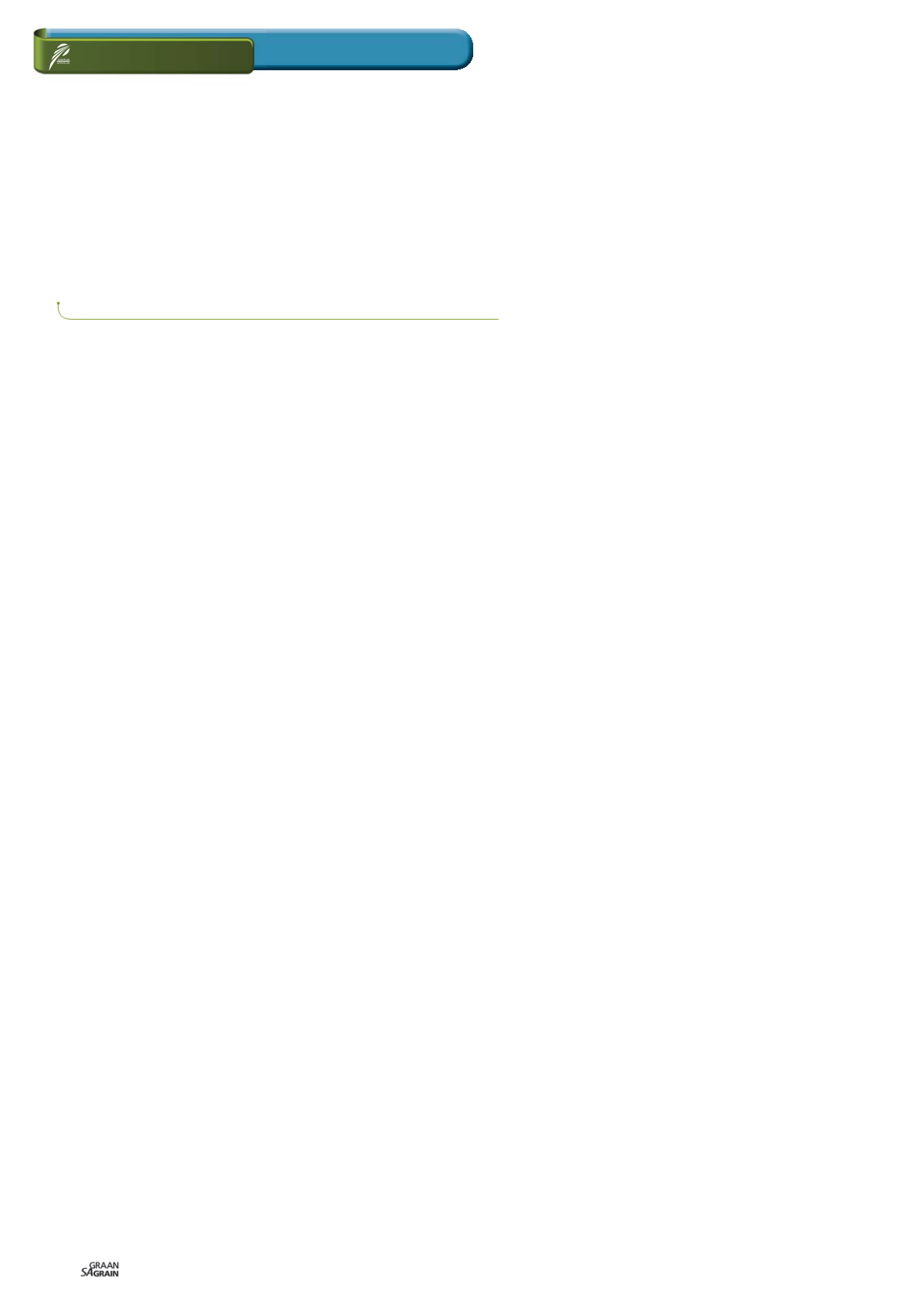

Oktober 2017
102
Quality overview of imported
and local maize
D
rought conditions experienced over large parts of the
maize production regions during the 2014/2015 maize
production season, together with the fact that the
South African weather service indicated that the 2015/2016
season represented the lowest annual rainfall in South Africa since
1904, resulted in increased white and yellow maize imports com-
pared to previous seasons, to support local demand.
The South African Grain Information Service (SAGIS) supply and
demand figures show that white maize imports during May 2016
to February 2017 increased from 100 803 tons during 2015/2016 to
648 885 tons. The ten-year average for white maize imports is
29 180 tons. Yellow maize imports decreased over the correspond-
ing period from 1 862 807 tons to 1 592 599 tons. The ten-year import
average for yellow maize is 435 374 tons.
Maize imports during the 2015/2016
marketing season
240 samples of imported maize were received at the Southern
African Grain Laboratory (SAGL) for quality analysis purposes and
of these, eight samples were white maize. 22% of the 240 samples
were downgraded to class other maize according to South African
grading regulations. More than half of these were downgraded
due to the presence of an undesirable odour and most of the re-
mainder as a result of poisonous seeds in excess of the maximum
permissible number, namely one per 1 000 g or seven per 1 000 g.
The results of the quality analyses performed on the imported
maize are compared to those of the local maize crop of the corre-
sponding class and grade and period (2014/2015). The 100 kernel
mass of the imported maize was higher on average, as were the
stress cracks.
The kernel sizes were more comparable than in previous seasons,
but still smaller. The smaller kernel sizes of the local maize due to
the drought conditions played a role. The average protein content of
the imported maize was lower than that of the South African maize,
while the average fat content was higher and the starch lower.
Multi-mycotoxin analyses were done on 75 composite samples per
shipment. The Fumonisin, Deoxynivalenol (DON) and Zearalenone
mycotoxin content was on average higher than locally produced
maize. 20 yellow maize samples exceeded the national maximum
Fumonisin (B
1
+ B
2
) level for raw maize intended for further pro-
cessing and six samples exceeded Fumonisin B
1
national maximum
limits for animal feed.
Maize imports during the 2016/2017
marketing season
To date, 269 samples of imported maize were received at the SAGL
for quality analyses purposes. The total number of samples include
86 white maize samples. 11% of the 269 samples were downgraded
to class other maize according to South African grading regulations.
More than half of these were downgraded due to the presence of an
undesirable odour.
The remainder was mostly downgraded as a result of total defec-
tive kernels exceeding the maximum permissible level of 30% or
the presence of live insects in the samples.
The results of the quality analyses performed on the imported
maize are compared to those of the 2015/2016 season local maize
crop. The 100 kernel mass of the imported maize was lower on aver-
age (except for the white maize), the stress cracks were higher. The
kernel sizes were more comparable than in previous seasons, but
still smaller.
The smaller kernel sizes of the local maize due to the drought con-
ditions again played a role, as in the previous season. The protein
content of the imported maize was on average 1,1% lower than that
of the South African maize, while the average fat and starch contents
were higher.
Multi-mycotoxin analyses have been completed on 85 composite
samples per shipment to date. Aflatoxin B
1
and B
2
residues were
detected on a couple of samples (five white and one yellow), the
B
1
levels exceeded national maximum levels.
The Fumonisin, Deoxynivalenol and Zearalenone mycotoxin content
was on average higher than locally produced maize. 27 yellow maize
samples and two white maize samples exceeded the national maxi-
mum Fumonisin (B
1
+ B
2
) level for raw maize intended for further
processing. Eleven yellow samples exceeded the national Fumonisin
B
1
maximum limits for animal feed.
Local production overview
The finalised crop figure for commercial maize for the 2015/2016
season as overseen by the National Crop Estimates Liaison Com-
mittee (CELC) is 7 778 500 tons. This is the lowest South African
maize crop since the 2006/2007 season when 7 125 000 tons of
maize were produced and presents a 22% reduction compared to
the previous harvest.
White maize’s contribution to the total production was
3 408 500 tons (43,8%) and that of yellow maize 4 370 000 tons
(56,2%). The major commercial maize-producing provinces are
Mpumalanga, the Free State and North West Province, contributing
72% of the total maize production in South Africa.
The impact of the extreme drought conditions experienced over
large parts of the maize production regions, is evident in the 26,6%
decrease in total area utilised for maize production compared to the
previous season.
The area decreased from 2 652 850 ha to 1 946 750 ha. White
maize was planted on 1 014 750 ha and yellow maize on 932 000 ha
(1 448 050 ha and 1 204 800 ha respectively in the 2014/2015 season).
The maize yield increased slightly from 3,75 t/ha in the previous sea-
son to 4 t/ha this season. White maize yielded 3,36 t/ha and yellow
maize 4,69 t/ha, representing increases of 2,8% and 8,3% respec-
tively compared to the previous season.
RELEVANT
JOLANDA NORTJÉ,
laboratory manager, Southern African Grain Laboratory NPC

















